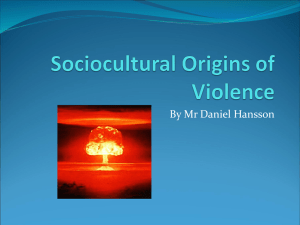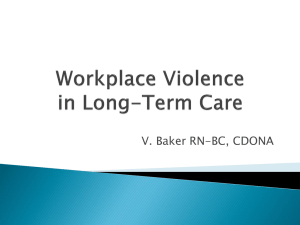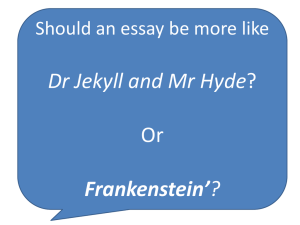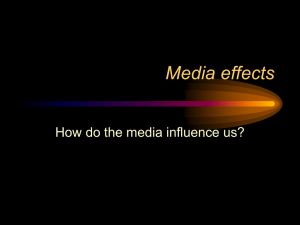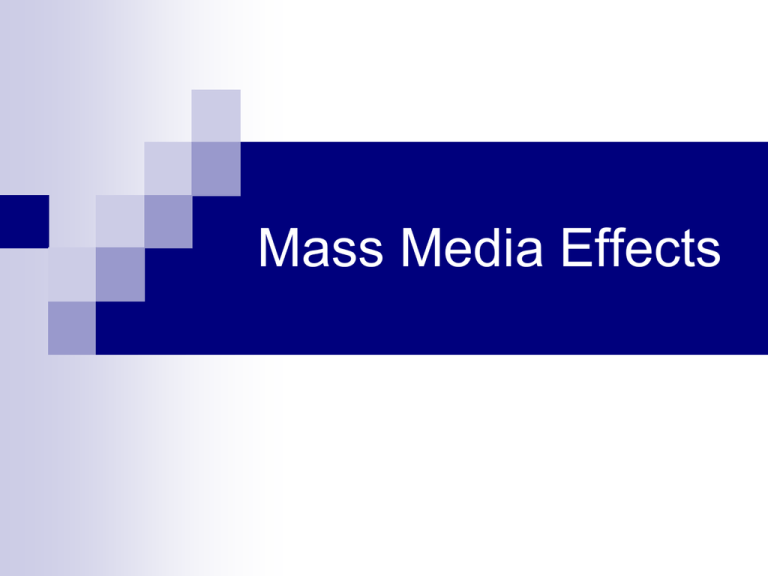
Mass Media Effects
Hostile
Media Effect: some feel
that media coverage is biased
against opinions on issues
Research
has shown that hostile
media effect is not just differences
of opinion but a difference of
perception
People
seem to pay more
attention to information that
contradicts rather than supports
their pre-existing views
Media
bias: non-uniform
selection or coverage of news
stories in media
Many Americans seek out biased
news- to find confirmation for their
preconceived opinions
Newspapers
used to reflect the
opinions of the publisher
1798: Congress passed the Alien
and Sedition Acts: prohibited the
publication of “false, scandalous,
or malicious writing” against gov’t
Made
it a crime to voice any
public opposition to any law or
presidential act- act was in effect
until 1801
1861:
Lincoln ordered many
newspapers closed when he felt
border states were biased in favor
of the Southern cause
19th
century: American
newspapers openly advocated
one or another political party
Editorials and editorial cartoonsgo against the publisher’s
opponents
20th Century: Yellow
journalism to increase sales
William Randolph Hearstpublisher of several major market
newspapers- deliberately falsified
stories, which may have
contributed to Spanish-American
War
Early
Leading
up to WWII- politicians
who favored U.S. entering the war
on the German side accused the
media of pro-Jewish bias, said
that newspapers were controlled
by the Jewish
Hollywood
was said to be full of
Jewish bias- pro-German
politicians in U.S. called for
Charlie Chaplin’s film The Great
Dictator to be banned- they said it
insulted a respected leader
1960’s-
Civil Rights Movementsome White Southerners stated
that television was biased against
White Southerners and in favor of
mixing the races- Star Trek didn’t
air on some Southern stations
1969:
Spiro Agnew (VP for
Nixon) said he saw the media as
bias against the Vietnam War and
called those who opposed the war
to be “nattering nabobs of
negativism”
American
Society of Newspaper
Editors in 1997- survey said 61%
of reporters stated they were
members of or shared the beliefs
of the Democratic Party
15% said their beliefs were
represented by the Republican
Party
2002
study- Dartmouth College116 mainstream U.S. papers (The
New York Times, Washington
Post, Los Angeles Times, San
Francisco Chronicle included)
found that mainstream press in
America tends to favor liberal
viewpoints
Reporters
who expressed
moderate or conservative points
of view were often labeled as
holding a minority point of view
Liberal bias about issues like
race, welfare reform,
environmental protection, and gun
control
Zogby
International- survey
results said that 83% of people
surveyed believe there is a bias in
the media, 64% said that the bias
favors liberals, 28% of
respondents believe the bias is
conservative
Patrick
Buchanan- The American
Conservative editorial- wrote the
liberal media establishment’s
reporting on the Watergate
scandal “played a central role in
bringing down the President.”
Nixon:
“I gave them a sword and
they ran it right through me.”
Books about Liberal Bias
John
Stossel- Give Me a Break:
How I Exposed Hucksters,
Cheats, and Scam Artists and
Became the Scourge of the
Liberal Media
Ann
Coulter- Slander: Liberal
Lies About the American Right
Brian C. Anderson- South Park
Conservatives: The Revolt
Against Liberal Media Bias
Claims of Conservative Bias
Disney,
CBS Corporation, New
Corporation, TimeWarner,
General Electric- corporate
conglomerates own the majority
of mass media outlets
Media
is operated for profitthrough the sale of
advertisements, which tends to
drive news, commentary, and
public affairs towards supporting
industry
Capitalist
model creates
competition for fair and quick
news coverage and investigative
reports
Rupert
Murdoch (CEO of News
Corporation- parent of FOX
News)
Richards Parsons- CEO of Time
Warner
Both contribute to Republican
candidates
Fox
News: “The roots of FOX
News Channel’s day to day on air
bias are actual and direct. They
come in the form of an executive
memo distributed electronically
each morning, addressing what
stories will be covered and, often,
suggesting how they should be
covered.”
Books on Conservative Bias
Eric
Alterman- What Liberal
Media? The Truth About Bias
and the News
Al Franken “Lies and the Lying
Liars Who Tell Them”
Concerns
about coverage of Iraqsaying that media had insufficient
coverage of invasion and
occupation, but some have also
said that media has been unfair to
US forces
Did
the U.S. media criticize the
conduct of American soldiers?
(some feel that media was
worried about upsetting viewers
and losing profits)
Some
though feel that media has
been too critical of U.S. forces
Media has failed to send a
message to support the U.S.
forces
Effects on Elections
Some
feel that elections on
centered on candidates, and the
amount of funds, personality, and
sound-bites instead of serious
political discussion or policies
offered by parties
Americans
are influenced by the
way the media reportconcentrated on short soundbites, scandals, mistakes by
candidates
Reporting
of elections avoids
complex issues or issues which
are time consuming to explain
Doonesbury:
comic strip,
accused of liberal bias
A conservative letter writing
campaign caused Doonesbury to
disappear from 38 newspapers,
but it was reinstated
Violent Media Effects
Television
61%
of TV shows are violent
Violence is on the rise for both
cable and broadcast networks
Few shows emphasize and antiviolence theme
40%
of violent scenes on TV
include humor
54% of violence is lethal
51% of TV violence shows no
pain
Out of 9000 analyzed over 4
years- only 4% had an anti-violent
theme
Media
violence can be one
contributing factor that leads a
person to exhibit aggressive
attitudes and behavior
Exposure
to media violence can
increase the probability of both
short and long term harmful
effects
Effects are mediated by
characteristics of the viewer
(demographics, psychological
states)
Media
violence does NOT affect
all viewers in the same way
Short Term Media Effects
Viewer
aggression: Bobo Doll
experiments in 1970’s
demonstrated how children who
watched violent media portrayals
were more likely to punch a Bobo
Doll afterwards than children who
did not watch a violent media
portrayal
Recent
studies find that kids who
watch violent television are at an
increased risk for aggression
Exposure to violent media
increases aggression and antisocial behavior in adults too
Fear
Kids
who are high television
viewers are more likely than low
television viewers to exhibit
symptoms such as anxiety,
trauma, and post-traumatic stress
When
kids view scary events in
the media, they become more
likely to fear those events in the
real world
Fear induced by media in
childhood is likely to linger into
adulthood
Desensitization
People
can become jaded even
after minimal exposure to media
violence
As a result, some individuals
exhibit a greater acceptance of
violence and a decrease in
empathy and concern for victims
of violence
Long Term Media Effects
Long
Term exposure to media
violence is related to aggression
in a person’s life
Longitudinal
research shows
childhood viewing of violence has a
causal effect on aggressive behavior
in adults
The degree to which viewers identify
with the characters who behave
violently impacts their likelihood of
exhibiting aggressive behavior
Once
children become adults,
their behavioral dispositions are
difficult to change
Media violence is related to
violence in society
When
TV is introduced into a
country, crime rates in the country
increase
When a high profile violent act is
depicted on television, the
incidents of criminal aggression
increase afterwards
(For
example, teen suicides
increase after a suicide appears
on a fictional TV program)
Exposure
to violence over time
leads people to exaggerate their
chances of being victimized
Research
conducted on this
theory states that:
The television world is a violent
landscape
As a result, TV viewers will
cultivate a view of the real world
that matches the TV world
They
will believe the world is a
mean and violent place
They overestimate the amount of
violence in society as well as their
chances of being victimized
Exposure to violence over times
leads people to grow more
accepting of violence
Similar to short term
desensitization effect- research
also shows that long term
exposure to media violence leads
people to be more accepting of
violence and less concerned
about victims of violence
Incitement
effects: the production
of a behavioral tendency towards
violence
Instructional effects: the teaching
of audiences of how to do
something
When
media produce an
incitement effect, the media have
created a behavioral tendency
that did not already exist (viewer
aggression is a behavioral effect
created by the media)
Instructional
effects might occur
when an already violent person
learns how to conduct a bloody
rampage by learning skills on
television
Industry Perspective
Violence
is a natural part of life Interviews with producers of the
top primetime shows say that
violence is just a natural part of
human life, and thus a natural
part of its cultural representations
Violence
is necessary component
of dramatic portrayals: Drama is
based on conflict, and violence is
a tool of conflict. Thus, many
dramatic portrayals will need to
portray violence
The
industry shows responsible
violence portrayals- They claim to
show the negative side of
violence
The
Hollywood industry has same
family values as the rest of
America- They claim that
Hollywood is not in fact
disconnected from the values of
mid-America
Media
violence does not harm
audiences anyway, even kids
Industry
has tried to deny that the
television landscape is a violent
space- They are selective in
supporting content analyses that
support their claims that television
is not violent
They
applaud a study conducted
by the UCLA Center for
Communications Policy, which
claimed that only 2 network
shows in 96-97 season raised
serious concerns about violence
Members
of the industry have
engaged in self-regulation of
media content
Most
networks have their own
departments of broadcasting
standards and research
departments
The
V-Chip provision of the
Telecommunications Act of 1996
Television industry devised its
own system of categorizing
programs for violence, sex, and
offensive language
The
V-chip technology involves
an electronic filtering device that
parents can use to block the
reception of sensitive or
potentially harmful programming
Parents
are reliant, however, on
the ratings assigned by the
networks themselves
1998 study found the 79% of all
shows containing violence did not
receive a V rating
Within
children’s programming,
81% of the programs with
violence did not receive an FV
rating for Fantasy Violence





